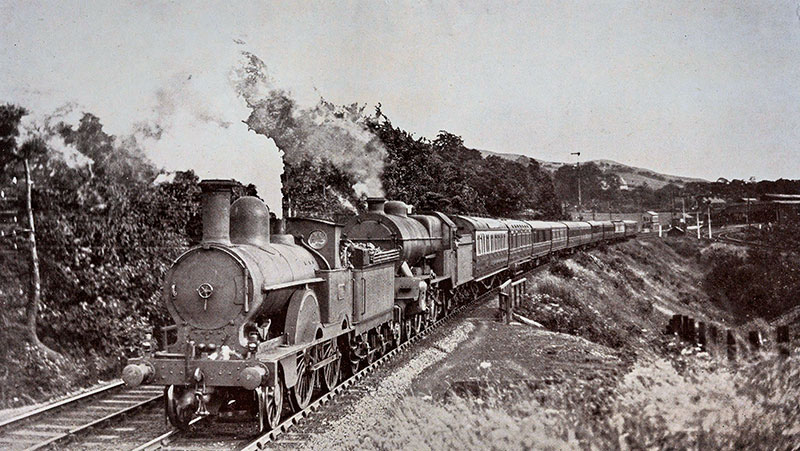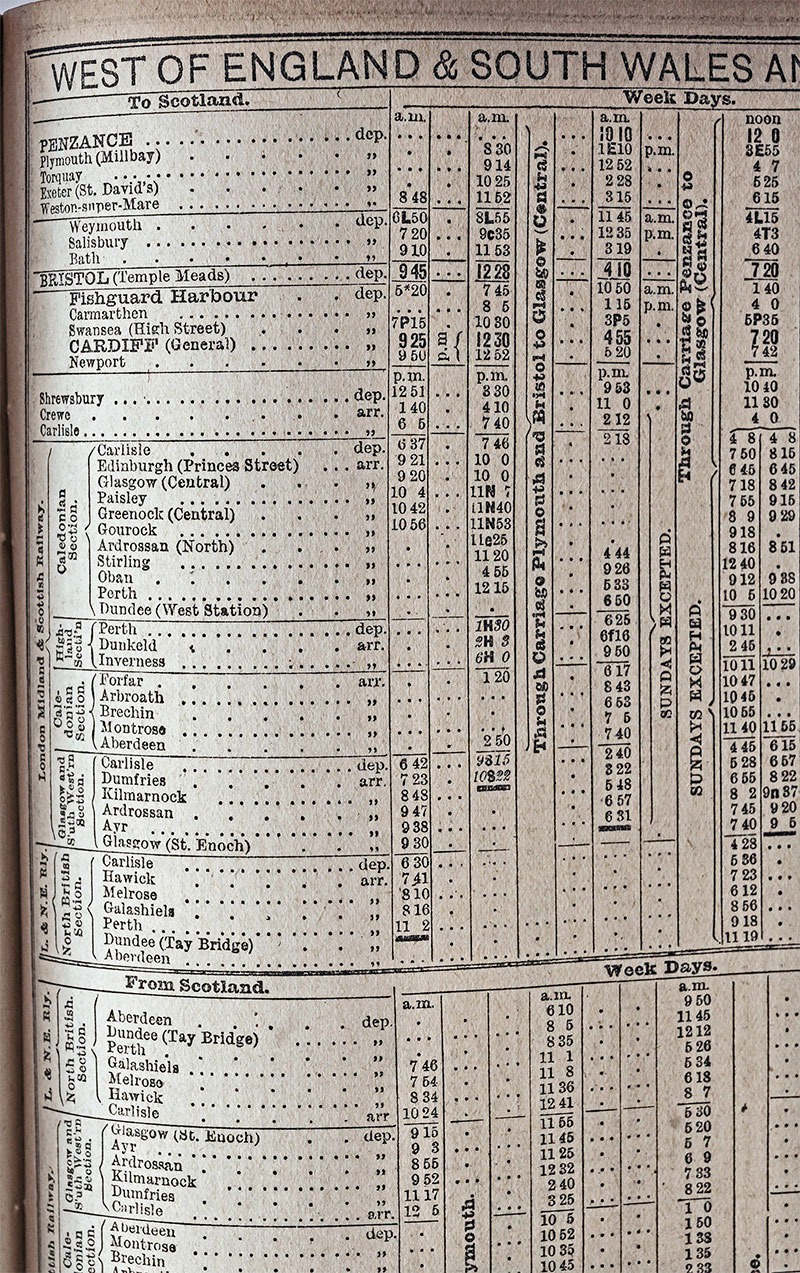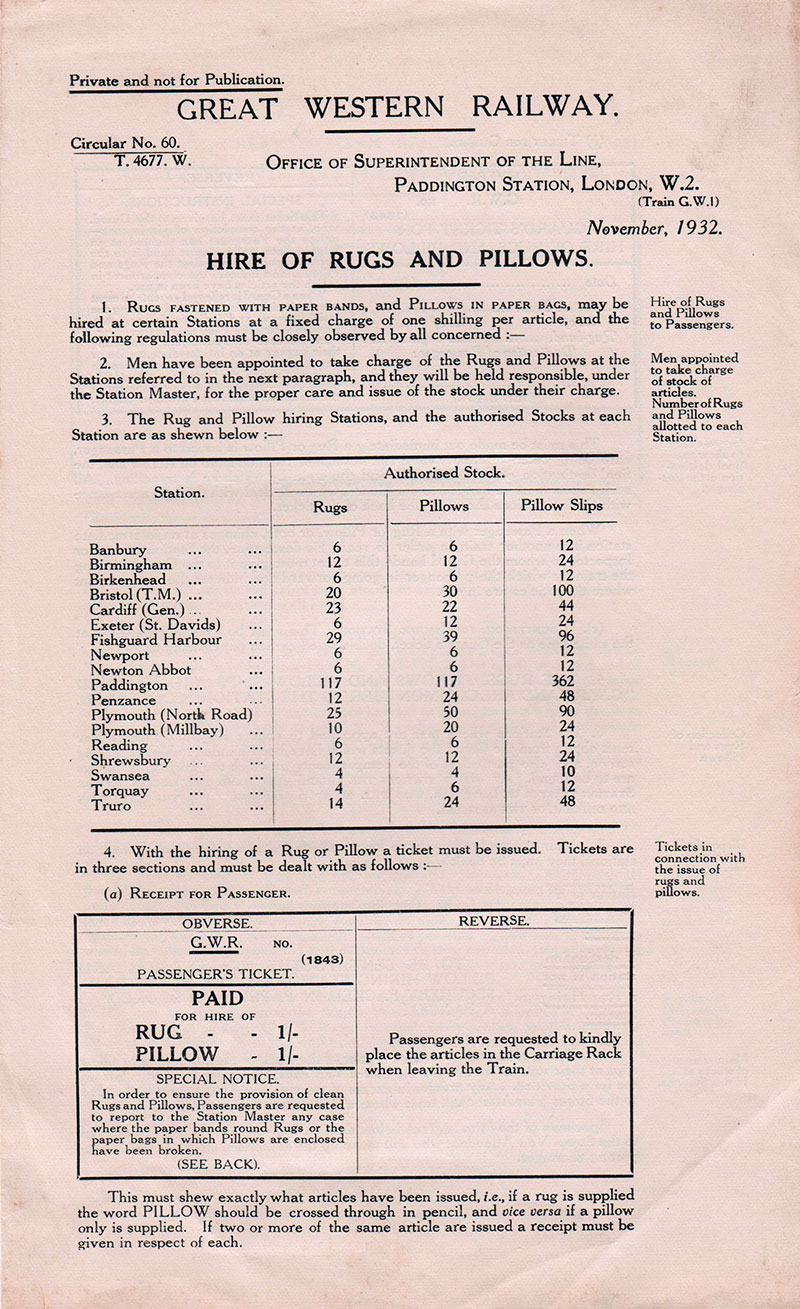Home » Other Articles » Tuesday Treasures Index » Tuesday Treasures - December 2022 - Tuesday Treasures - December 2022
Tuesday Treasures - December 2022
TUESDAY 20 DECEMBER
A GWR carriage a long way from home
Our Tuesday Treasure this week takes us a long way from Great Western territory, to Oxenholme, and an unexpected Great Western presence.
Browsing recently in The Railway Magazine edition of February 1927 (the Great Western Trust has a full collection in its library at Didcot) we saw this rather attractive photo, by H Gordon Tidey, of a London & North Western Railway ‘Jumbo’ 2-4-0 No 364 piloting a Lancashire & Yorkshire Railway Hughes 4-6-0 No 10462 near Oxenholme on the 1.30pm Euston to Glasgow.
Looking closely at the photo, we realised the leading coach is a GWR one. So we then went to the Great Western Trust’s collection of timetables from the 1920s and found an entry on the West of England and South Wales to Scotland page for a through carriage to Glasgow. It left Plymouth at 8.30am and arrived in Glasgow at 10pm – a fairly leisurely journey to enjoy in the comfort of a Great Western compartment, no doubt punctuated by visits to the restaurant car. The time at Crewe of 4.10pm coincides with the likely schedule of the 1.30pm from Euston for the GWR coach to be attached there.

No 364 had been built in October 1894 as a member of the Improved Precedent class of 2-4-0s, nicknamed ‘Jumbos’. During the Railway Race to the North in 1895, No 790 Hardwicke of the same class set a record of two hours and six minutes for the 141 miles from Crewe to Carlisle, with an average speed of 67.1 mph. Hardwicke is now preserved by the National Railway Museum.
No 364 was named Henry Pease, who was a director of the Stockton and Darlington Railway and later a director of the North Eastern Railway. He was born in 1807, a son of Edward Pease who was a founder of the Stockton and Darlington Railway. Edward Pease vies with George Stephenson for the title of ‘Father of the Railways’
Henry Pease was a liberal MP for Durham South from 1857 to 1865, a pacifist and a Quaker. He died in 1881.
The Hughes 4-6-0s were introduced in 1908 when George Hughes was Chief Mechanical Engineer of the Lancashire & Yorkshire Railway. The first batch of 20 locomotives was completed in 1909. They were nicknamed ‘Dreadnoughts’ because of their size (after the Royal Navy’s new large warships), in the same way as the GWR’s 70ft long carriages got the same nickname.
The Hughes 4-6-0s, however, were described as ‘sluggish, poor runners and poor steamers’. It must have been galling to Hughes and the L&Y directors that their ‘Dreadnoughts’ performed so poorly, while the GWR's Stars with a similar specification (4-6-0, 4-cylinders) performed so well.

Fifteen of the original Hughes 4-6-0s were rebuilt in 1920-1 with Walschaerts valve gear and superheaters, and 55 more were built new. They still gobbled coal. No 10462 in this photo was one of the final batch, built in 1924-5. She had a relatively short working life, being withdrawn in 1935.
George Hughes went on to become Chief Mechanical Engineer of the London Midland & Scottish Railway when the west coast companies amalgamated at the grouping of the railways in 1923. He retired in 1925 and was succeeded by Sir Henry Fowler who had a Midland Railway background, including that company’s small engine policy. Fowler retired in 1931 and was succeeded for a year by Ernest Lemon, until William Stanier was headhunted from the GWR in 1932, to reform LMS locomotive policy.
Thank you for reading our Tuesday Treasure blogs this year. We are taking a break for the festive season, and will be back with you in 2023.
TUESDAY 13 DECEMBER
Christmas for the Departmental Railway Staff
In our previous blogs leading up to Christmas, the natural focus was upon the anticipation of presents and all the activities associated with this big holiday festival. We also blogged on the 1959 posted message from the British Transport Commission Chairman, Sir Brian Robertson, to all its staff, male and female, seeking their continued very hard work leading up to Christmas when the population expected trains to run for passengers and their posted presents!
This time we explore the Great Western Trust Collection in the unpublicised, but very important seasonal connection between Departmental HQs and their personnel. Naturally such material, dedicated to a single year, rather long ago now, and sent to a staff member, are rare treasures to have come down to us now. So here we illustrate just one, for 1951, from the Head of Civil Engineering on the Western Region.

Depicting a busy pre-Christmas scene across the arched transept at Paddington, probably as a sketch created by a member of their staff. It is quite a feature of the officially organised and sponsored GWR and BRWR staff recreational activities, that the ‘Arts & Crafts’ activities were highly valued and contributed to by the staff. Many of them were quite creative and accomplished artists, a feature that the Trust collection has examples of, and which we can use in a future blog.
TUESDAY 6 DECEMBER
Warmth and Comfort for GWR Passengers
With our weather heading into winter and much colder days, we thought it a good opportunity to look back to how the Great Western Railway provided for additional passenger comfort, and the organisation of staff, depots and administration that accompanied it.
From the Great Western Trust collection we focus upon a very detailed Circular to Staff dated November 1932, entitled ‘Hire of Rugs and Pillows’. It was issued under the authority of one of the GWR’s highly regarded Superintendents of the Line, Mr R H Nicholls.

90 years ago, this circular (title page illustrated) not only places a firm responsibility upon “men appointed to take charge” of the process at stations, but of course reminds if they needed it, that Station Masters were also part of the proper actions! Quite how the tabulated stations had their numbers of rugs and pillows stocks quantified is not explained, but even Plymouth Millbay station, the terminus for ‘Ocean ship passengers’ had an allocation.
The administration and due procedures, come to dominate the detail. Not only were special forms created, one for each rug and pillow if both paid for by a passenger, but even the train guard had to have his copy too, and he would be required to ensure that if the passenger then changed train to another GWR one, that transfer of rug and/or pillow, was concurrently recorded so that the new train guard had those papers! The circular continues for two more pages, detailing the manner in which used items were to be gathered and if needed returned to their originating stations, if soiled, where and how to package and send them, and just to tidy up the records, a weekly return of items so used, on its unique GWR form, was to be submitted!
All that for a fee of one old shilling per hired item (5p in today’s currency, value £2.75 allowing for inflation). We should add that the Trust collection contains both the brown paper wrappers used for such hire, and a delicately printed pillow case too, and the high quality rugs (with ‘GWR’ emblazoned upon them of course).
Further research reveals in the Great Western Railway Magazine August 1924 edition an article ‘Tips for Travellers’ advises:
“If they intend travelling by a night train, they will find they can hire a pillow and rug from any of the principal stations.”
The same magazine’s October 1928 edition announces sleeping cars now being available for 3rd class passengers for a fee of six shillings (30p) in addition to the fare, adding: “Each passenger is supplied with a rug and pillow.” There were four berths in a compartment, shown in this photograph from the magazine, with the rugs in use.

The opportunities for overnight travel in the 21st century are more limited, although the Night Riviera still offers sleeping cars from London to Penzance.
Didcot Railway Centre Newsletter
Stay up to date with events and what's going on at Didcot Railway Centre.
You may unsubscribe at any time. We do not share your data with 3rd parties.